Last Updated on December 3, 2024 by Kittredge Cherry
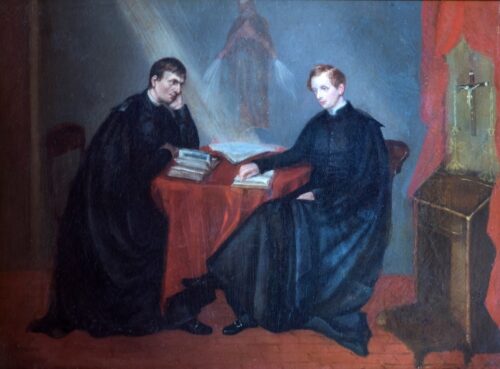 John Henry Newman, a 19th-century British scholar, theologian and cardinal, was canonized by the Pope as a Roman Catholic saint in 2019 amid rampant speculation that he was gay. Newman’s feast day is Oct. 9 in the Roman Catholic church, Feb. 21 in the Episcopal Church and Aug. 11 in the Anglican church.
John Henry Newman, a 19th-century British scholar, theologian and cardinal, was canonized by the Pope as a Roman Catholic saint in 2019 amid rampant speculation that he was gay. Newman’s feast day is Oct. 9 in the Roman Catholic church, Feb. 21 in the Episcopal Church and Aug. 11 in the Anglican church.
Newman and another priest, Ambrose St. John, lived together for 32 years and share the same grave. Some say they shared a “romantic friendship” or “communitarian life.” It seems likely that both men had a homosexual orientation while abstaining from sex. Newman described St. John as “my earthly light.” The men were inseparable.
A portrait of Newman and St. John together in Rome was painted by Maria Giberne, an amateur artist and a lifelong friend of the Newman family who followed him into the Catholic church. It appears at the top of this post. She painted the couple sitting together with their books in one of their rooms at the Propaganda College in Rome on June 9, 1847. standing between them is Our Lady of the Miraculous Medal, a devotional image of the Virgin Mary, who appears to be blessing and watching over the priests who loved each other.
During the beatification process, the Vatican tried to violate Newman’s desire to be buried with his beloved companion. Vatican officials hoped to excavate and move his remains to a specially built sarcophagus in Birmingham in preparation for his beatification. Controversy arose as some LGBTQ activists saw the decision to disturb the shared grave as an attempt to separate them and cover up the queer side of Newman’s life. However when the grave was opened in 2008, the remains had completely decomposed, leaving nothing that could be separated.
“I consider the failure to separate their remains a queer miracle for canonization,” said queer theologian Robert Shore-Goss, a former Catholic Jesuit priest and author of the classic “Jesus Acted Up: A Gay and Lesbian Manifesto.”
Newman (Feb. 21, 1801 – Aug. 11, 1890) is considered by many to be the greatest Catholic thinker from the English-speaking world. He is Britain’s most famous 19th-century convert to Catholicism. Newman was born in London and ordained as an Anglican priest. He became a leader in the Oxford Movement, which aimed to return the Church of England to many Catholic traditions. On Oct. 9, 1845 he converted to Catholicism. He had to give up his post as an Oxford professor due to his conversion, but eventually he rose to the rank of cardinal.
Many other 19th- and early 20th-century British LGBTQ literary and intellectual figures were converts to Catholicism, including writers Radclyffe Hall, Oscar Wilde, and Gerard Manley Hopkins. Poet Christina Rossetti was deeply involved in the Anglo-Catholic movement without actually converting.
Newman and his beloved were ordained together
Ambrose Saint John (1815 -1875) apparently met Newman in 1841. They lived together for 32 years, starting in 1843. St. John was about 14 years younger than Newman. He compared their meeting to a pair of Biblical women joined by a lifetime vow: Ruth and Naomi. In Newman’s own words, St. John “came to me as Ruth came to Naomi” during the difficult years right before he left the Anglican church.
After converting together to Catholicism, they studied together in Rome, where they were ordained priests at the same time. When St. John was confirmed in the Catholic faith, he asked if he could take a vow of obedience to Newman, but the request was refused. Newman recalled their early years in this way:
“From the first he loved me with an intensity of love, which was unaccountable. At Rome 28 years ago he was always so working for and relieving me of all trouble, that being young and Saxon-looking, the Romans called him my Angel Guardian.”
 St. John, a scholar and linguist in his own right, helped Newman with his scholarship and shared other aspects of daily life as if they were a couple in a same-sex marriage. John Cornwell, author of Newman’s Unquiet Grave: The Reluctant Saint
St. John, a scholar and linguist in his own right, helped Newman with his scholarship and shared other aspects of daily life as if they were a couple in a same-sex marriage. John Cornwell, author of Newman’s Unquiet Grave: The Reluctant Saint, told National Public Radio that St. John’s support for Newman included “even doing things like packing his bags before he went away, making sure he was taking his medicine, making sure he kept dental appointments, that sort of thing. So it was almost like a wife, but without the marital bed.”
Discussion of Newman’s queerness dates way back. His contemporary John Campbell Shairp described how Newman’s preaching style at Oxford in the 1840s defied gender norms by being “so strong yet so tender; the grasp of a strong man’s hand, combined with the trembling of a woman’s heart.” The 1933 psychological biography “Oxford Apostles” by Geoffrey Faber. He writes that Newman’s first intense male friendship was with his colleague Hurrell Froude: “Of all his friends Froude filled the deepest place in his heart, and I’m not the first to point out that his occasional notions of marrying definitely ceased with the beginning of his real intimacy with Froude.”
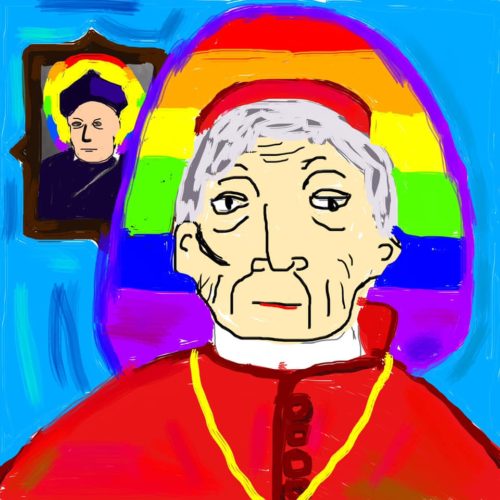
“Cardinal John Newman and his earthly light Fr Ambrose St John” by Jeremy Whitner.
Newman has a rainbow halo — and his beloved Ambrose St. John behind him — in a 2020 icon that emphasizes his gay aspect. It was painted by North Carolina artist Jeremy Whitner, a gay Christian mystic in process for ministry with the Disciples of Christ.
Vatican consultant James Martin, a Jesuit priest, was attacked by conservative Catholic media in 2019 when he tweeted that Newman may have been gay:
“This doesn’t imply that the man who will become a saint tomorrow ever broke his promise of celibacy. And we may never know for sure. But his relationship with Ambrose St. John is worthy of attention. It isn’t a slur to suggest that Newman may have been gay. Why is the question important to consider? Even if we may never know for sure? Because it reminds us that a gay person (someone with a homosexual orientation, if you prefer) can be holy, even a saint. Holiness makes its home in humanity.”
Martin is the author of “Building a Bridge: How the Catholic Church and the LGBT Community Can Enter into a Relationship of Respect, Compassion, and Sensitivity.”
Newman grieved when his soulmate died
They lived together until St. John died on May 24, 1875. He was about 60 years old. According to a memorial letter written by Newman himself, St. John died of a stroke that “arose from his overwork in translating Fessler, which he did for me to back up my letter to the Duke of Norfolk.” Newman needed a translation of the German theologian Joseph Fessler’s important book in the wake of the First Vatican Council.
In the memorial letter Newman goes on to describe their dramatic last moments together, including how St. John clung to him closely on the bed and clasped his hand tightly. Newman, unaware that his beloved companion was dying, asked others to unlock his fingers before saying the goodbye that turned out to be their last.
Newman was heartbroken by the loss of his beloved partner. “I have always thought no bereavement was equal to that of a husband’s or wife’s, but I feel it difficult to believe that anyone’s sorrow can be greater than mine,” Newman wrote.
He insisted three different times that he be buried in the same grave with St. John: “I wish, with all my heart, to be buried in Father Ambrose St. John’s grave — and I give this as my last, my imperative will,” he wrote, later adding: “This I confirm and insist on.”
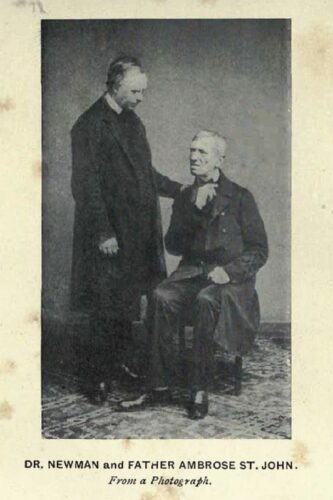
A rare photo shows John Henry Newman, left, and Ambrose Saint John together. (Wikipedia)
Newman died of pneumonia on Aug. 11, 1890 at age 89. According to his express wishes, he was buried with St. John. The shroud over his coffin bore his personal coat of arms with the Latin motto, “Cor ad cor loquitur” (Heart speaks to heart), which he adopted when he became cardinal. Their joint memorial stone is inscribed with a Latin motto chosen by Newman: “Ex umbris et imaginibus in veritatem.”(Out of the shadows and reflections into the truth.”) They share a small grave site in the central English town of Rednal.
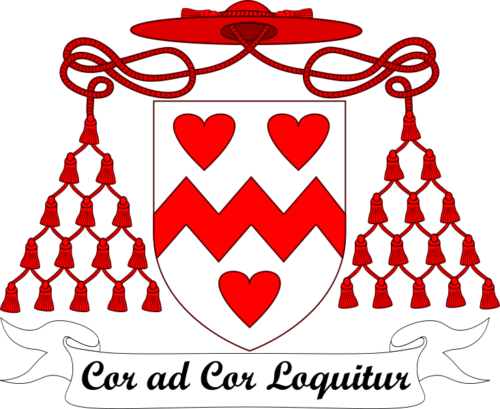
John Henry Newman’s coat of arms with the motto “heart speaks to heart” (Wikimedia Commons)
Pope canonized Newman in 2019
Newman, Britain’s most famous 19th-century convert to Catholicism, is the first English person born since the 17th century to be declared a saint by the Catholic church — and the first English saint be canonized by the Catholics in almost 50 years.
Pope Francis canonized Newman and four women in an open-air ceremony in Saint Peter’s Square in Vatican City on Oct. 13, 2019. It was attended by tens of thousands of people, including Prince Charles. Many more followed the event through international news reports. The Pope read a quote from one of Newman’s sermons, adding, “Let us ask to be like that, kindly lights amid the encircling gloom.” The following video includes scenes from the canonization ceremony and the Pope speaking about Saint Newman.
Newman’s legacy is vast
Newman’s legacy is wide-ranging. Because Newman was an excellent scholar, Catholic centers on U.S. college campuses are named after him. Newman tells his own story in his acclaimed spiritual autobiography, Apologia pro Vita Sua. The title is Latin for “A Defense of One’s Life” and Newman was fluent in Latin, but he wrote the book in English. He is known for writing the poem “The Dream of Gerontius” and the popular hymn “Lead, Kindly Light.”
He even wrote two novels, both exploring conversion experiences that are similar to his own — once with a male character (“Loss and Gain”) and once with a female protagonist (“Callista: A Tale of the Third Century.”) He was so literary that he thought it would disqualify him from sainthood, writing to an admirer, “I have nothing of a Saint about me as everyone knows…. Saints are not literary men, they do not love the classics, they do not write Tales.”
He publicly opposed cruelty to animals, comparing the suffering of abused animals to the suffering of Christ and writing, “Cruelty to animals is as if man did not love God.”
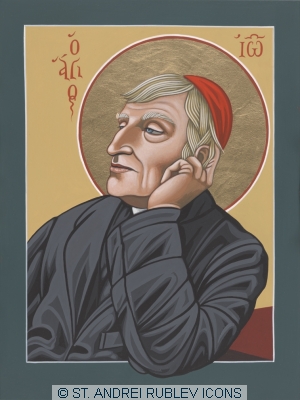
“Blessed Cardinal John Henry Newman: Lead Kindly Light” by William Hart McNichols ©
His theology of friendship and his emphasis on conscience are both significant for LGBTQ people and allies. Although the Catholic church tends to frown on special friendships among priests, nuns or monks, Newman taught, “The love of our private friends is the only preparatory exercise for the love of all men.” He preached, “The best preparation for loving the world at large, and loving it duly and wisely, is to cultivate our intimate friendship and affection towards those who are immediately about us.”
His wisdom includes the popular quote, “Learn to do thy part and leave the rest to heaven.” It appears along with his face on mugs available at the DrinklingsCoffeeMugs Etsy shop. The new mugs were released in fall 2019 just in time for his canonization.

Newman’s face with his words of wisdom on a mug available at Etsy.
Other popular quotes by Newman include:
“To live is to change, and to be perfect is to have changed often.”
and
“Fear not that thy life shall come to an end, but rather fear that it shall never have a beginning.”
Terence Weldon at Queering the Church explains how Newman’s teaching on conscience laid the groundwork for LGBT Christians today. “As a theologian, Cardinal Newman played an important role in developing the modern formulation of the primacy of conscience, which is of fundamental importance to LGBT Catholics who reject in good conscience the standard teaching on sexuality – or the high proportion of heterosexual couples who reject ‘Humanae Vitae,’” Weldon writes.
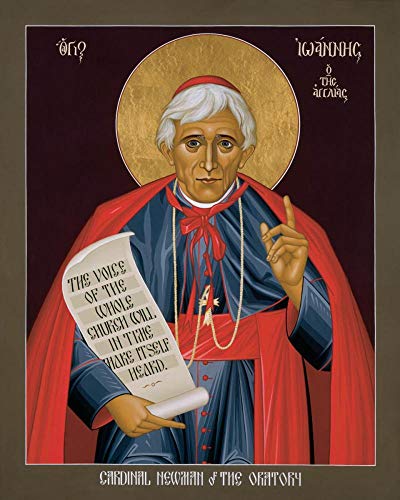
John Henry Newman by Robert Lentz.
This post is illustrated with icons of Newman by Robert Lentz and William McNichols. Both artists faced controversy for their alternative and LGBTQ-affirming images. The icon above is by Brother Robert Lentz, is a Franciscan friar known for his innovative and LGBTQ-positive icons. Prints are available at Trinity Stores.
Newman is honored by Catholics on Oct. 9, the anniversary of his 1845 conversion from Anglicanism to Catholicism. Naturally Anglicans chose a different date for Newman’s feast day — the anniversary of his death on Aug. 11.
With beatification, Blessed Newman is now only one step away from official sainthood. He is already a saint in the hearts of many, including the LGBTQ people who are inspired by his life and love.
His name is invoked in an official Catholic prayer:
O God, who bestowed on the Priest Blessed John Henry Newman
the grace to follow your kindly light and find peace in your Church;
graciously grant that, through his intercession and example,
we may be led out of shadows and images
into the fulness of your truth.
___
Author’s note: I decided to write this comprehensive piece about the love between Newman and St. John in 2011 when I discovered that it had not been done yet on the Internet from a LGBT-positive viewpoint. I was one of many bloggers on both sides who wrote about whether Newman was gay at the time of his beatification, citing a few facts. I thought I would just do a quick update to focus on his achievements and his relationship with St. John.
But as I got into the research, I was surprised both by how compelling their love story is, and how hard it was to find an overview of their relationship on the Internet. Details of their deep love for each other are available on the Web, but mostly on websites that aim to prove they were not homosexual. It’s odd how they end up supporting the very point that they are trying to discredit. So I put it all together from a queer point of view.
Links related to John Henry Newman
English cardinal John Newman to be declared a saint (theguardian.com)
Cardinal John Henry Newman to be become first English saint in 50 years, Pope confirms (telegraph.co.uk)
Was Cardinal John Henry Newman Gay? (NPR)
Was a would-be saint gay? (Time.com)
Reflections on the Life and Legacy of John Henry Newman (Wild Reed)
Author interview: “Queer Martyrdom from John Henry Newman to Derek Jarman” by Dominic Janes (Jesus in Love)
World’s largest Newman-related digital archive: National Institute for Newman Studies database
Oratio ad Christum Iris Arcus (Rainbow Christ Prayer in Latin)
___
To read this post in Spanish / en español, go to Santos Queer:
Beato John Henry Newman y Ambrose St. John: Un santo gay y su “luz terrenal” comparten una amistad romántica
To read this post in Italian, go to:
Il beato John Henry Newman e Ambrose St. John, la sua “luce sulla terra” (gionata.org)
___
Top image credit:
Portrait of John Henry Newman and Ambrose St John by Maria Giberne, 1847 (Catholic Church England and Wales Flickr)
This post is part of the LGBTQ Saints series by Kittredge Cherry. Traditional and alternative saints, people in the Bible, LGBTQ martyrs, authors, theologians, religious leaders, artists, deities and other figures of special interest to lesbian, gay, bisexual and transgender and queer (LGBTQ) people and our allies are covered.
This article has evolved and expanded greatly since the first version was posted in August 2011. It was published on Q Spirit in January 2017, was enhanced with new material over time, and was most recently updated on Dec. 2, 2024.
Copyright © Kittredge Cherry. All rights reserved.
Qspirit.net presents the Jesus in Love Blog on LGBTQ spirituality.






















See
“Fall of Father Dr. Wolfgang Rothe
… And he fell, and his fall was great – Mt 7,27)” :
https://gloria.tv/post/LUpCzi9KybgA23DjcZtZGjKNw
Although it is not connected to John Henry Newman, this is quite an interesting article about gay German priest Wolfgang Rothe, so I am approving your comment.
There has always been people layman , Religious , Cardinals and Sr. But choose not to live a a same sex attraction lifestyle. There are many same sex attracted faithful Layman in the church again they just live a chaste life realizing that being same sex attracted is a fleshly passion like other sinful passions that are only sinful if acted upon. That’s also the teaching of the Catholic Church.
I think they shared a very deep friendship, in other words, a bromance. They both could have homosexual tendencies but they vowed to God to keep themselves in celibacy. So in the end they had a bromance which is absolutely not in contradiction with being saint. In the other hand if they would have had actual sex then they would had broken their vow to God which would have been a grave sin. Because when you marry God you cannot marry another human, you can love them deeply, but cannot give them your body cause you already offered your body to God. I’m an aspirant to religious life as a nun and I think I’m bisexual but no matter how much affection I can feel for another human I already decided to give my body all to God and live in celibacy, so Saint Henry Newman is a great inspiration on how I can love without deviating from God’s plan of salvation.
You said: ‘Some say they shared a “romantic friendship” or “communitarian life.”’ The phrase “some say” is the definition of gossip or speculation, which in this case has no evidentiary basis other than the fact that they were friends who lived together. The phrase “communitarian life” would not imply homosexual inclination, and “romantic friendship” is just one modern activist’s construction on the matter.
I have a book published in 1765, “Fireworks”. Inscribed on the first page is the name “Ambrose St John”, I have always assumed it was this mans. I am a practicing Catholic but deplore the decision to separate these two men and also to focus unduly on their (presumed) sexuality which was a private matter and should be respected. They were both great men who led by example of love and goodness, I am not sure that they would want all this fuss. I will treasure the book always.
aul, how wonderful to have a book inscribed by Ambrose St. John! Thank you for telling us about your treasured book and your thoughts about him and John Henry Newman.
I’m happy Saint Newman was part of the Oxford Movement which returned much of Anglican tradition to its Catholic roots. Now High Church Anglicans and Episcopalians are more “Catholic” than many Catholics when it comes to ceremonies and traditions.
Is it possible that same-sex intimate friendships are so rare these days, esp. on account of the hyper-sexualized meaning human intimacy of any kind has acquired in the pornographic age, that it was not their passion for one another that was disordered, but rather our view of it? (If my use of the word “passion” immediately suggests sex when you hear it used in that sentence, then the answer is almost certainly yes.)
There are similar stories about the love between natural brothers. Should we infer incest from those accounts of deep friendship? Should we think it not possible for such love and intimacy to exist without sexual attraction and temptation? Or should we just lament our spiritual poverty and inability to understand the joyous virtue of amicitia?
History abounds in such friendships (most fraternal but some sororal). Not a few of them have been sources of great spiritual and intellectual culture. It used to be thought that such power was the outpouring of human love forged in the bonds of virtue and devotion to the truth. Now it seems we are content to eroticize the whole history of friendship away.
Is it any wonder that the de-masculinizing bro culture is irresistible to so many young men who wish not to be assumed homosexual just because they take pleasure in same-sex friendship?
The Catholic Church teaches that homosexual inclination, in and of itself, is not a sin. I appreciate the honesty of Kittredge in not insisting that a sexually intimate relationship was necessarily part of John Henry and Ambrose’s relationship. Even if it was implied. Of the honest biographies of Newman that I have read, this is also the case. Could he not be the perfect patron for those who struggle (or do not struggle, but who are still seeking truth) with how to appropriately live out a love for someone of the same sex.
You make it sound dirty if indeed he shared physical love with his partner. He was in love, I feel confident he shared his body with the man he loved.
After a relationship of 55 years with my late partner I can only say love is love, as two men we shared everything. I can well understand the grief and devastation that Cardinal Newman as I too experienced. It is time the church changed and at the least be able to give a blessing for a same sex relationship. It would encourage same sex relationships to be loyal and faithful to each other,rather than this permissive society of today. I have not one single regret that I shared my life with life with a man I truly loved and to know that he loved me to the end. He waits patiently for me in heaven.
Thank you for sharing your experience with the love of your life. My heart goes out to you in the loss of the man who was your same-sex partner for 55 years. I love the thought of him waiting patiently for you in heaven. Your words are an inspiration to me as creator of this blog, and to others who read what you wrote.
The irony of this claim is Newman’s great personal and professional sacrifice in battling the rise of the liberalism that was promoting this very sort of self-defined “Truth.” Activists today claim that real love must always be sexual–that sexual expression is THE primary freedom. Thus we are no longer allowed bosom friends without the implication of sexuality. The activist attempts of “members” of a church or any other organization or franchise to deny its core doctrines or restrictions is sheer folly. (Picture a “member” of the Sierra Club stumping for the drilling of off-shore oil.)
I hope they enjoyed intimate sexual relations. What a pity if they did not.
Unfortunately, if it were proven that they did enjoy intimate sexual relations, the canonization would not be taking place.
What an inspiration to Gay Christians of all denominations.